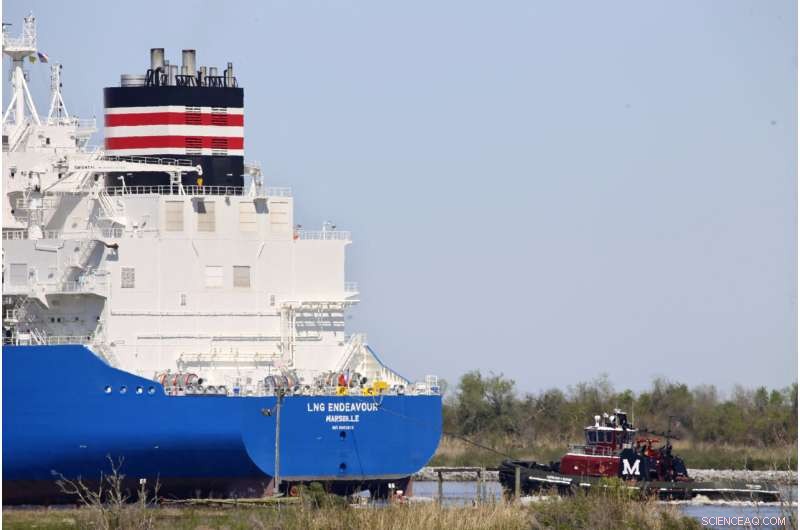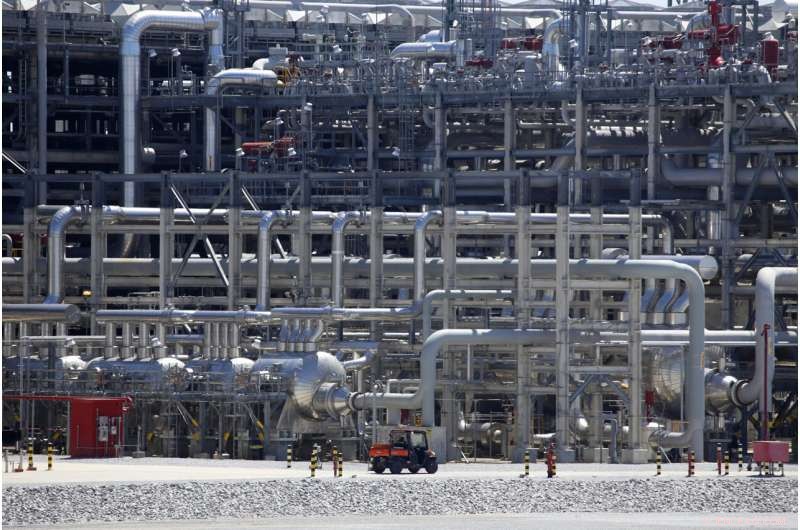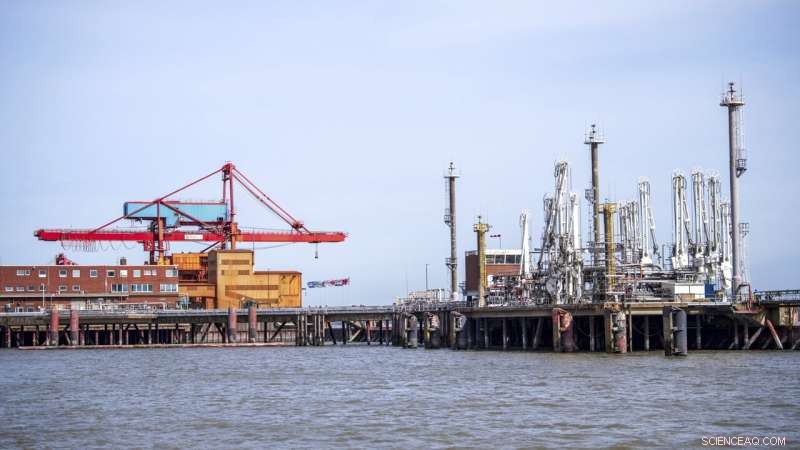
Um rebocador ajuda a guiar um navio francês, conhecido como LNG Endeavor, pelo lago Calcasieu, perto de Hackberry, Louisiana, em 31 de março de 2022. A guerra da Rússia contra a Ucrânia destruiu suas relações com a Europa, que logo perdeu a maior parte do gás natural que Moscou tinha longo fornecido. Agora, à medida que o inverno se aproxima, os países europeus apoiaram uma correção de curto prazo prevista para começar antes do final de 2022, que levantou alarmes entre os cientistas que temem as consequências de longo prazo para o clima. Crédito:AP Photo/Martha Irvine, Arquivo
À medida que o inverno se aproxima, os países europeus, desesperados para substituir o gás natural que compraram da Rússia, adotaram uma solução de curto prazo:uma série de cerca de 20 terminais flutuantes que receberiam gás natural liquefeito de outros países e o converteriam em combustível de aquecimento.
No entanto, o plano, com os primeiros terminais flutuantes prontos para fornecer gás natural até o final do ano, levantou alarmes entre os cientistas que temem as consequências de longo prazo para o meio ambiente. Eles alertam que esses terminais perpetuariam a dependência da Europa do gás natural, que libera metano e dióxido de carbono que aquecem o clima quando é produzido, transportado e queimado.
Alguns cientistas dizem temer que os terminais flutuantes acabem se tornando um fornecedor de longo prazo das vastas necessidades de energia da Europa que podem durar anos, se não décadas. Essa tendência pode atrasar os esforços de redução de emissões que, segundo especialistas, não foram rápidos o suficiente para retardar os danos causados ao meio ambiente global.
Grande parte do gás natural liquefeito, ou GNL, que a Europa espera receber deverá vir dos Estados Unidos. A necessidade surgiu depois que a invasão da Ucrânia pela Rússia rompeu seus laços com a Europa e levou a um corte da maior parte do gás natural que Moscou havia fornecido há muito tempo. Ao longo da Costa do Golfo dos EUA, os terminais de exportação estão se expandindo, e muitos moradores estão alarmados com o aumento da perfuração de gás e a resultante perda de terra, bem como mudanças climáticas extremas associadas à queima de combustíveis fósseis.
“Construir esta imensa infraestrutura de GNL irá prender o mundo a uma dependência contínua de combustíveis fósseis e danos climáticos contínuos nas próximas décadas”, disse John Sterman, cientista climático do Instituto de Tecnologia de Massachusetts.
O gás natural contribui significativamente para a mudança climática – tanto quando é queimado, transformando-se em dióxido de carbono, quanto por meio de vazamentos de metano, um gás de efeito estufa ainda mais potente. No entanto, as nações europeias, que há anos são líderes na mudança para energia mais limpa, propuseram trazer mais de 20 terminais flutuantes de GNL para seus portos para ajudar a compensar a perda de gás natural da Rússia.
Os terminais, que se erguem sobre casas e se estendem por quase 304 metros, podem armazenar cerca de 170.000 metros cúbicos de GNL e convertê-los em gás para residências e empresas. Eles podem ser construídos mais rápido e mais barato do que os terminais de importação onshore, embora sejam mais caros de operar, de acordo com a União Internacional de Gás.
"Todo país precisa se preparar para um cenário em que pode haver um corte no fornecimento russo", disse Nikoline Bromander, analista da Rystad Energy. "Se você é dependente, precisa ter um plano de backup."

Um flare queima na Venture Global LNG em Cameron, Louisiana, em 21 de abril de 2022. A guerra da Rússia contra a Ucrânia destruiu suas relações com a Europa, que logo perdeu a maior parte do gás natural que Moscou forneceu há muito tempo. Now, as winter nears, European nations have backed a short-term fix set to begin before the end of 2022 that has raised alarms among scientists who fear the long term consequences for the climate.Credit:AP Photo/Martha Irvine, File
Many environmental scientists argue that the money being earmarked for the ships—which cost about $500 million each to build, according to Rystad—would be better spent on rapidly adopting clean-energy or efficiency upgrades that could reduce energy consumption.
Constructing more solar or wind farms, which takes years, wouldn't immediately replace Russian gas. But with adequate funding, Sterman suggested, greater energy efficiencies—in homes, buildings and factories, along with the deployment of wind, solar and other technologies—could vastly reduce Europe's need to replace all the gas it's lost.
Germany, among Europe's strongest advocates for the floating LNG terminals, is expecting five of the ships and has committed roughly 3 billion euros to the effort, according to Global Energy Monitor. Germany has also approved a law to fast-track the terminals' development, suspending the requirement for environmental assessments.
It's a move that troubles environmental groups.
"It's totally obvious," asserted Sascha Müller-Kraenner, CEO of Environmental Action Germany, that "the provisions of the law were developed in close dialogue with the gas industry."
Germany's government and energy industry have defended their embrace of the LNG terminals as an urgent response to the loss of most of the Russian gas they had long received, which they fear Moscow will shut off completely.
"In an exceptional situation such as this, where it's a matter of Germany's gas supply security, it is justified to accelerate the approval process," Germany's energy industry association, BDEW, said in a statement.
Susanne Ungrad, a spokeswoman for Germany's Economy and Energy Ministry, noted that efforts are being made to lower methane emissions in exporting countries like the United States. And she said that in pursuing the construction of LNG terminals, Europe authorities will conduct comprehensive assessments.

A small vehicle drives past a network of piping that makes up pieces of a "train" at Cameron LNG export facility in Hackberry, La., on March 31, 2022. Russia’s war against Ukraine shattered its relations with Europe, which soon lost most of the natural gas that Moscow had long provided. Now, as winter nears, European nations have backed a short-term fix set to begin before the end of 2022 that has raised alarms among scientists who fear the long term consequences for the climate. Credit:AP Photo/Martha Irvine, File
Greig Aitken, an analyst at Global Energy Monitor, noted that a terminal that's set to open near Gdansk, Poland, has signed contracts with American LNG suppliers that extend well past 2030. That could make it problematic for the European Union to meet its goal of reducing greenhouse gas emissions by at least 55% by 2030.
Italy, Greece, France, the Netherlands, Croatia, Estonia, Finland, Latvia, Slovenia and the U.K. all have one or more floating LNG terminals planned, according to Rystad Energy.
In some cases, proponents argue, the ships could aid the environmental cause. They note, for example, that as Russian gas supplies have dwindled, communities in Germany and elsewhere have been burning coal, which typically produces more emissions than natural gas. Increasing the supply of natural gas would make this less necessary.
Still, methane can frequently leak along the natural gas supply chain. So in some cases, the net climate effect of burning natural gas may be no better than coal.
The U.N. Intergovernmental Panel on Climate Change has warned that continuing to use the fossil fuel infrastructure already in place would cause global warming to exceed 1.5 degrees Celsius (2.7 Fahrenheit). At that level, heat would be expected to worsen the flash floods, extreme heat, intense hurricanes and longer-burning wildfires that have resulted from climate change and have cost lives.
"It is a little disheartening to see Europe, which has been the seat of so much energy and action and bold emissions targets, being home to this particular way with doubling down on fossil fuel infrastructure," said Kim Cobb, a climate scientist at Brown University.
In the United States, the largest export market for Europe-bound LNG, three new export terminals are under construction. Eleven additional terminals and four expansions are in the planning stages. Some export terminals that had struggled to attract financing are now seeing more investment and interest, said Ira Joseph, a longtime energy analyst.
"What you've seen happen over the last two months—they're signing up sales and purchase agreements, right and left," Joseph said.

The area in front of the Stade Industrial Park is part of the future port expansion for the planned import terminal for liquefied natural gas (LNG) in Stade, Germany, on April 2022. Russia’s war against Ukraine shattered its relations with Europe, which soon lost most of the natural gas that Moscow had long provided. Now, as winter nears, European nations have backed a short-term fix set to begin before the end of 2022 that has raised alarms among scientists who fear the long term consequences for the climate. Credit:Sina Schuldt/dpa via AP, File
Rio Grande LNG, an export terminal proposed by Next Decade in Brownsville, Texas, for example, appeared to stall last year in the face of environmental protests. But this spring, a French company, Engie, and several clients in Asia signed long-term contracts to buy LNG from the terminal. Now, Next Decade says it's likely to obtain all the financing it needs.
Europe's gas scarcity has escalated global LNG prices, leading buyers in China and elsewhere to sign long-term contracts with suppliers in the United States. American LNG exports will likely grow by 10 million tons over the next year, said Bromander, the Rystad analyst.
The floating LNG ships have been billed as a short-term solution to keep gas flowing for a few years while cleaner energy sources like wind and solar are built up. But critics say it's unlikely that a ship built to last decades would permanently halt operations after a few years.
Once the floating terminals are built, they can be used anywhere in the world. So if European nations no longer want floating LNG terminals as they transition to cleaner energy, the ships could sail off to another port, essentially locking in the use of natural gas for decades.
And in some cases, particularly in Germany, some of the proposed floating terminals appear to be paving the way for on-shore terminals that would be built to last 30 or 40 years—well past the point that nations should be burning fossil fuels, environmental groups say.
"After the war is resolved and, as we all hope, peace is restored, are they really going to say, 'Oh, let's take it to the scrap yard?,'" Sterman asked. "They're not going to do that."
+ Explorar mais EU decision on natural gas could threaten climate progress
© 2022 The Associated Press. Todos os direitos reservados. Este material não pode ser publicado, transmitido, reescrito ou redistribuído sem permissão.



